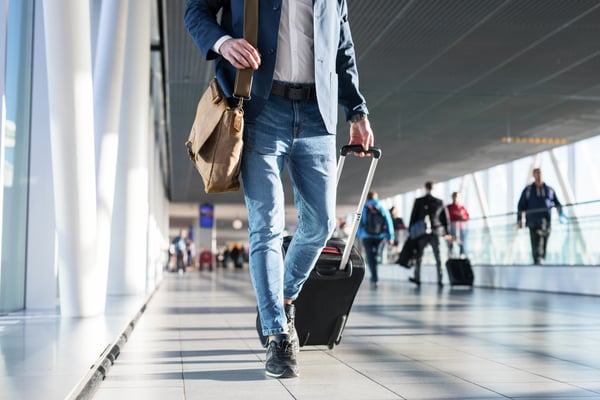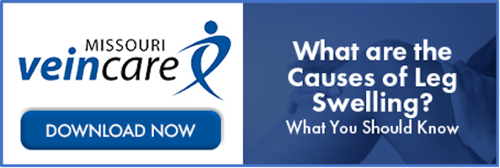Travel Tips for People with Vein Conditions

Vacation season is often something we look forward to, but what happens when the thought of being confined to a car or airplane makes you reconsider going at all? For those with a vein condition, traveling can feel dreadful. The discomfort from swollen, achy legs and the inability to find relief can make you want to cancel the trip. When the thought of a "relaxing" vacation causes more anxiety than excitement, it may be time to find a better way.
Don’t let your vein condition stop you from enjoying your travels! Here are some suggestions to make the journey a little less painful and a lot more enjoyable.
Key Takeaways
- Persistent swelling that lasts for days during a trip is often caused by high salt intake from restaurant and processed foods, not just your vein condition.
- Swelling from a vein condition typically goes away overnight after lying flat, while salt-induced swelling lingers for days.
- Simple actions during travel, like wearing compression stockings, staying hydrated, moving around frequently, and avoiding salty foods, can make a huge difference in your comfort.
- Starting vein treatment even a few weeks before a trip can provide enough symptom relief to help you travel more comfortably.
Why Do My Legs Swell So Much on Vacation?
Since vein conditions are so common, affecting about one in three adults, many people experience symptoms when they travel. I often hear from patients, "Gosh, I went on a trip and my legs were swollen the whole week." They show me pictures, and it looks truly miserable.
But here’s something I’ve observed that isn't widely discussed: This prolonged swelling often has more to do with the food you're eating than just the vein condition itself.
Here’s the key difference: swelling associated with a vein condition typically goes away overnight. When you sleep flat in bed, gravity is no longer working against you, and the fluid redistributes. By morning, your legs should look and feel much better.
If you have swelling that lingers for several days to a week, it doesn't automatically mean something more serious is wrong. Most likely, it means you have taken in a lot more sodium, or salt, than you're used to. Our bodies are designed to hold on to salt as a survival mechanism. It can take three days or even longer for your body to get rid of excess salt. When you're on vacation, eating at restaurants or grabbing fast food at the airport, you're consuming a lot of hidden salt. Your body holds onto this salt by retaining water, and the result is uncomfortable, persistent swelling.
Preparing to Travel
When you are flying, try to book an early flight. This will allow for more time in the day before the triggers and symptoms start to occur. Plan on having a few activities or books to keep your mind occupied and not focused on your legs. You can download games, movies, or TV shows. Most importantly, don’t forget to pack your medications that you need for your car or plane ride.
Depending on the length of your travel, you may be sitting for longer periods of time. It is important that you stand, stretch, or walk around when you can. If flying, it’s never a bad idea to call ahead, explain your situation, and set up an arrangement for special seating. Accommodated seating, such as an aisle seat, will give you more space to be comfortable and move around if needed. Finally, make sure to pack Tylenol or over-the-counter pain medication if needed toward the end of the day.
Consider your vacation plans. If you’re going to do more walking than you are accustomed to, like visiting museums or walking tours, plan ahead to wear compression stockings.
Preparing for Your Trip
A little preparation can go a long way in making your travel day more comfortable.
- Book Smart: When flying, an early flight can be helpful, as vein symptoms often worsen as the day goes on. Try to get an aisle seat to give yourself more room to stretch and make it easier to get up and walk around.
- Plan for Comfort: Pack loose, comfortable clothing. Tight clothes, especially around the waist and legs, can restrict blood flow and make swelling worse.
- Pack Distractions: Have books, games, or movies downloaded and ready. Keeping your mind occupied can help you not to focus on the discomfort in your legs.
- Consider Pre-Trip Treatment: If the appearance of your legs makes you hesitant to wear shorts or skirts, starting vein treatment 3-6 months before your trip can make a big difference, as it takes time for veins to fade after treatment. However, even getting one or two treatments right before you leave can provide enough relief from symptoms like aching and heaviness to make your trip more enjoyable. You can simply resume your treatments when you return.
During Travel
Avoid Triggers:
If you find yourself battling with legs that are uncomfortable and aching, managing a few common triggers can significantly improve your situation, particularly during long travel days. It's beneficial to steer clear of alcohol, which can dehydrate your body and worsen the discomfort. Similarly, caffeine can lead to dehydration and increase restlessness, exacerbating leg discomfort. Additionally, wearing tight clothing can restrict blood flow, leading to increased discomfort and swelling. By avoiding these triggers, you can help alleviate some discomfort associated with aching legs, especially when you are traveling.
Walk When Possible:
Whenever you have the chance, make an effort to walk. If you're driving, take regular breaks to stretch your legs and walk around. At the airport, use your waiting time as an opportunity to explore the terminals on foot. During flights, once the airline attendants give the all-clear, take a stroll down the aisle every hour or so. This helps to prevent stiffness and promote circulation. If standing up isn't an option, engage in seated exercises such as rolling your ankles, wiggling your toes, and bending and straightening your legs. Repeat these movements every hour to keep your blood flowing.
Walking and doing these leg exercises are crucial because they activate the calf muscle pump, a vital mechanism that helps force blood back up the legs toward the heart. This action is especially important during long periods of inactivity, such as sitting in a car or on a plane, as it can prevent blood from pooling in your legs, reducing the risk of clots and enhancing overall circulation. Activating the calf muscle pump through these simple exercises ensures that your blood continues to circulate efficiently, contributing to your cardiovascular health and reducing the risk of deep vein thrombosis (DVT). Embracing these habits not only keeps you healthier but also makes long-distance travel more comfortable and safer.
Watch What You Eat and Drink
- Avoid Excess Salt: Hidden sodium is everywhere in fast food, restaurant meals, and processed snacks. To avoid days of bloating and swelling, try to bring your own non-processed food.
- Pack Healthy Snacks: Nuts, fruits, and vegetables are great travel-friendly options. A small travel cooler in the car can keep these snacks fresh and make it easier to avoid unhealthy temptations.
- Stay Hydrated: Dehydration can make vein symptoms worse. Ditch the sodas and sugary drinks in favor of water. Drinking plenty of water helps your circulation and has the added benefit of making you get up to use the restroom, which forces you to move around.
- Limit Alcohol and Caffeine: Both alcohol and caffeine can contribute to dehydration and may increase restlessness, making your leg discomfort worse.
Avoid Excess Salt:
Fast food, salty snacks, and restaurant food are all designed to be irresistibly tasty rather than healthy. These options typically come with a heavy dose of salt, which is not easily processed by the body. If you consume a large amount of salt, expect it to take 3-4 days for your body to fully eliminate it. During this time, you'll likely experience bloating, discomfort, and noticeable swelling, which can be quite unpleasant. Therefore, it's important to be mindful of your salt intake and consider the potential effects on your body before indulging in these foods.
Stay Hydrated:
The importance of water to our health simply cannot be overstated. Ditching sodas and sugary fruit drinks in favor of water can significantly contribute to providing your body with the essential hydration it needs to maintain optimal health. Water plays a critical role in regulating body temperature, ensuring that blood flow is maintained at a healthy level.
Moreover, the act of drinking enough water to prompt regular trips to the restroom has an added benefit: it keeps you moving, adding a bit of physical activity to your daily routine. This subtle form of exercise can enhance your overall well-being by keeping your muscles engaged and promoting circulation.
Wear Compression Stockings:
This becomes particularly crucial while flying, as cabin pressure experiences fluctuations throughout the flight, impacting your comfort and health. We recommend compression socks with a pressure range of 20-30mmHg, advising that you wear them for the entire duration of your travel to maximize benefits. To ensure they fit well and are comfortable, it's a good idea to try them on a few days before your trip. This allows for any adjustments if needed.
For those embarking on journeys of 8 hours or more, you might discover that the open-toe style offers additional comfort, making it easier on your feet over long periods. Wearing the right compression socks can significantly enhance your flying experience, reducing discomfort and promoting better circulation.
Traveling with a vein condition isn’t always ideal, but there are ways to make you more comfortable on your car or plane ride. Bottom line, a vein condition is never a good reason for canceling a trip. Go ahead and book your vacation and pack your shorts...then call us to help you make the trip as enjoyable as possible.
Frequently Asked Questions (FAQs)
1. Why do my legs swell so much more on a plane?
The combination of prolonged sitting and changes in cabin pressure can make it harder for your body to circulate blood effectively from your legs back to your heart. This causes fluid to pool, leading to noticeable swelling.
2. What is the best type of compression stocking for travel?
For most travelers, knee-high compression stockings with 20-30mmHg of pressure are sufficient and are the easiest to manage. They provide excellent support for your lower legs, where swelling is most common during travel.
3. I have swelling for days on vacation. Is this my vein condition or something else?
While a vein condition contributes, swelling that lasts for several days without improving overnight is often a sign of high salt intake. Restaurant food and processed snacks are loaded with sodium, which causes your body to retain water.
4. How often should I get up and move during a long flight or car ride?
Try to get up, stretch, and walk around for a few minutes at least once every hour. If you can't get up, do seated leg exercises like ankle rolls and calf raises every hour to keep your blood flowing.
5. Will starting vein treatment right before my trip help?
Yes. While cosmetic results take time, having even one or two treatments before you travel can significantly reduce symptoms like pain, aching, and heaviness, making your trip much more comfortable.
Whether you found us by searching Missouri Vein Care or Missouri Vein Care Columbia, MO, our team is dedicated to delivering effective diagnosis and treatment. Many new patients begin their research by searching for Missouri Vein Clinics. If you are interested in learning more about your vein symptoms. No matter where you’re located in Mid-Missouri, we’re here to support your care journey.




